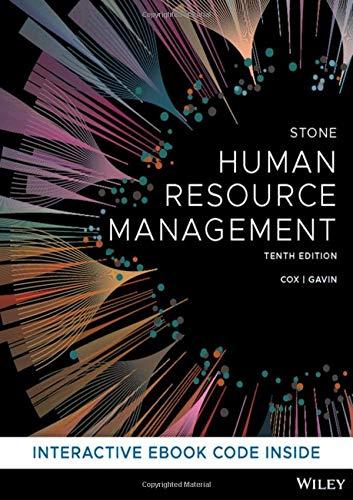Oz Consolidated has a five-level performance appraisal system using a forced ranking distribution. Superior performers (the top
Question:
Oz Consolidated has a five-level performance appraisal system using a forced ranking distribution. Superior performers (the top 5 per cent) are rated 1, very good performers (the next 15 per cent) are rated 2, good performers (the next 70 per cent) are rated 3, marginal performers (the next 5 per cent) are rated 4 and unsatisfactory performers (the bottom 5 per cent) are rated 5 . Employees rated 5 are given 3-6 months to improve their performance before they are considered for termination. Merit pay increases are awarded only to those rated 1,2 or 3 . Employees rated 4 and 5 are given only legally required pay increases. Promotions, bonus payments and stock options (granted only to those rated 1 or 2 ) are designed to foster a performance culture. Although meant to be confidential, employees quickly learn the ratings of other people in the organisation. Employees with a 1 rating are informally referred to as 'superstars', those with a 2 rating are called 'stars', employees rated 3 are called 'workhorses', those with a 4 rating are called 'near misses' and 5 ratings are referred to as 'deadwood'.
Problems can arise when a superstar is seen by their colleagues as belonging to another rating group. This causes envy among other workers and reluctance by them to communicate and cooperate with the superstar employee. The typical attitude is that if they are such 'hotshots', they don't need my help. Likewise, a problem exists with a number of employees rated 3 because they regard their rating as really meaning that they are just average. As a result, they become demotivated, and the better ones (especially the borderline 2 's) frequently quit the company. A major source of contention also exists with those graded as 'deadwood'. Some managers argue that a 5 rating resulting in termination is too harsh, implies that the employee can't be 'saved', and does not sit well with an Australian egalitarian culture. Other managers argue that the system works properly by weeding out the non-performers and that by recognising, rewarding and motivating top performers it has allowed the company to prosper in a very competitive business environment.
Another complication occurs with those rated marginal. A formal distinction is made in the performance appraisal record between employees who have been given a 4 rating because they are new or learning a job and those whose performance is rated 'marginal' because, (although trained and experienced), they do not meet the required performance standard. However, no such distinction exists in the minds of most workers. The result is that good employees become demotivated and refuse to move to a new position (reducing their career development opportunities). Managers, as a consequence, face difficulties when trying to efficiently allocate their labour resources.
The upshot of all of this is that many managers claim that the forced distribution of employees (where managers rank each employee from 1-5) creates too much ill feeling and should be abolished. Some managers (especially the more politically powerful), frequently argue that their subordinates are all superior and therefore, are unfairly disadvantaged if restrictions are imposed on the numbers who can receive a superstar or star rating. Conversely, other managers object to rating employees in their department a 1 or 2 just to satisfy a theoretical distribution when they regard them as undeserving. All of this has created much discussion within the HR department about how to overcome the considerable dissatisfaction with the performance appraisal program present among the company's managers and employees.
DISCUSSION QUESTIONS
1. Identify the major stakeholders and discuss their likely views on the existing performance appraisal program.
2. Identify the strengths and weaknesses of the present program. Explain how you would overcome the weaknesses.
3. Is performance appraisal (especially one using forced ranking) inappropriate for employees? Why? Why not?
Step by Step Answer:

Human Resource Management
ISBN: 9780730385356
10th Edition
Authors: Raymond J. Stone, Anne Cox, Mihajla Gavin





